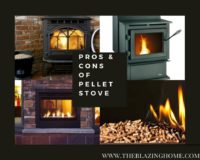After the end of the hot summer, we welcome autumn. At the beginning of the autumn, the utility bills of our house start rising up slowly. The heating system of your house is the main culprit of this sudden spike. Furthermore, the cost of gas, oil, and electricity is increasing day by day. We have left no choice but to look after an alternative fuel source. We can’t deny the wood pellet as an alternative to this problem.

Wood pellet stoves have started gaining popularity in many developed countries like the U.S.A, Canada, and the U.K. Nowadays, it has become the best heating solution for many modern houses and apartments. But, why is the use of pellet stoves increasing? Well, you may find the answer to this question if you know the benefits of using a pellet stove. Today, in this article, our expert will discuss the pros and cons of pellet stoves minutely. After reading this article, you may come to a decision that you should convert to the pellet stove or not.
Basics Of Pellet Stove
Pellet stove runs basically on wood pellets which is the main fuel for this type of stove. It burns pellets and the heat produced from the burning of pellets distributed inside the house with the help of a heat powered wood stove fan and thus it heats the entire house. It is also cost-effective. Pellet stoves are specially designed to burn wood pellets which are made from corn kernels, sawdust, wood chips, and nutshells. Their sizes are like rabbit foods. Usually, Premium wood pellets are sold in a 40 lbs bag. It will cost you 3$ to 10$ each (180$ to 250$ per ton). It is less expensive than fossil fuels and electricity. Who uses the pellet stove as the main heating source, use 2-3 tons of pellet per year.
The operation of a pellet stove is very simple. First, you need to plug the stove heater into the power outlet. Don’t switch on the pellet stove yet. You have to replenish the hopper with wood pellets. Commonly, hoppers are usually designed to hold 35-130 lbs of wood pellets at a time. After refilling the hopper with pellets, next you have to light the pellets. If your pellet stove has a built-in ignition system then you are very lucky. Since you don’t need to light wood pellets manually. Only you have to press the auto ignition button. That’s it. The pellet stove will start distributing heat around your whole apartment.
The Video Will Describe Pros & Cons Of Pellet Stove
Pros of Pellet Stove
1. High Efficiency
Undoubtedly, pellet stoves are the most efficient stove among the available heating system. A Pellet stove certified by the U.S. Environmental Protection Agency (EPA) is likely to be found in the rating of 70% to 83% heating efficiency range. On the other hand, the heating capacity range of a pellet stove starts from a minimum of 8000 BTU per hour to 100000 British Thermal Unit (BTU) per hour. Normally, for a standard room of 2000 square feet, you may need a pellet stove of 60000 BTU. Basically, these types of stoves are specially made to warm a large size home, apartment, or condominium.
But, it may not work perfectly if you select a pellet stove model with underrated or overrated BTU. Selecting a pellet stove with an accurate BTU rating is very important. So measure the required BTU very carefully before going to invest in a pellet stove. The best practice will be to use a BTU calculator, very easy to understand the parameter and easy to use.
2. Eco-Friendly
Pellet stove emits a very low amount of smoke and toxic chemical compounds compared to wood or gas stove. Burning fossil fuels like gas, oil, wood, and coal produce a huge amount of greenhouse gases like carbon dioxide (CO2 ), Carbon monoxide( CO), etc. Pellet stoves are not completely carbon neutral since they produce a very low amount of carbon gases. This amount of toxic gas released by the pellet stove doesn’t that risky for us.
The executive director of the United States Industrial Pellet Association (USIPA) said that wood pellets are a low-cost and low-carbon alternative as they are lower in sulfur, nitrogen, chlorine, and other toxic chemical gases than traditional fuel fossils.
Furthermore, Pellets are produced from recycling biomass waste like sawdust, wood waste, nutshells, etc. Thus, it is one of the finest sources of renewable energy which means it helps to keep the environment clean.
3. Easy Installation

Compare to a wood stove, pellet stoves are really easy to install since it doesn’t need high costing chimney system like a wood stove. This is because the pellet stove doesn’t produce massive smoke or gases. So, it doesn’t need a complicated venting system like a wood stove.
Best Pellet stove always comes with this air vent pipes included with the box most of the time. The installation of an air vent pipe is very easy and simple. You have to dig up a small hole in the wall to set up the vent pipe with your stove.
This vent pipe will send the toxic gases outside. One can easily install it without hiring a professional if he/she has some basic knowledge about drilling and cutting the wall. Just follow the instructions of the user manual. But to maximize the efficiency of your pellet stove, you should consider hiring a professional. We recommend you hire a certified professional from the National Fireplace Institute (NFI). National Fireplace Institute has a list of Professionals who can carefully conduct chimney installation to floor protection.
4. Budget-Friendly
You can easily get a pellet stove from your nearest shop or Amazon.com. The basic price of a pellet stove is between 1000$ to 3000$. It is less expensive than other existing heating sources. Moreover, you don’t need to add any chimney or special ventilation. So, the cost easily comes in your budget.
5. Easy Maintenance
Pellet stoves are easy to maintain. They produce less smoke compared to other types of wood-burning heating sources. So, there is no fear about building up creosote ( buildup that deposits in the flammable chimney) with pellet stove. You don’t have to be worried about maintaining and replacing the catalytic converter (which is a very common and important part of a wood stove) since there are no such things present in a wood stove. The manufacturer advises regularly cleaning and inspecting the motor and blowers. Always remove unused pellets from the hopper at the end of the winter season. It will reduce the chance of rusting inside the hopper. If you connect your stove to a chimney, then clean the chimney for preventing soot buildup.
6. Clean-Burning
Wood pellets are very clean-burning. Wood pellets burn well and produce less smoke. Moreover, pellets burn slowly and completely. Generally, woods don’t burn completely inside the wood stove since wood is not a clean burner like pellets. If you observe the pellet-burning in a pellet stove, you may rarely find partially or not burned pellets inside your stove.
7. Economical
Burning wood pellets is less expensive than burning woods, gas or running a heater utilizing electricity. This is because the wood pellets are less expensive. They cost you less if you buy wood pellets in bulk for one whole season.
8. Don’t Attract Pests
The woodburning stove needs a good storeroom outside your home. Keeping a stack of wood inside the house may attract snakes, mice, and various pests & insects. Pellets are easy to carry and store since they come with premium plastic bags. So, you can store it inside a drawer or storeroom. Furthermore, they don’t attract harmful pests like woods.
Cons of Pellet Stove
1. Noisy
Some pellet stove makes little noises, for which you may find it annoying. Two-component of a pellet stove are mainly responsible for this kind of irritating sound. One is the motor to combustion air and another one is blower fan. Sometimes the belt of the blower fan makes the sound. The sound is not unbearable. After some days you will be adjusted with this sound. But, if you find the sound louder day by day, then it’s your manufacturer’s default. At that time, without any delay contact the customer care department of the manufacturer.
2. Require Electricity
Pellet stove requires a little bit of electricity to run. Fans, electric controllers, and the pellet feeder need electricity to maintain the stove. It uses electricity worth 9$ per month. It will not run without electricity. Must reserve a backup power source to maintain when there will be no electricity.
3. Complex
Pellet stove has several parts that require regular maintenance. It has parts like a motor, blower fan, temperature sensors, and hopper feed. They need some annual or monthly maintenance and you may find them very complex. It may cost a handsome amount of money.
4. Costly If Fuel Supply Is Not Available
The price of pellet sometimes looks expensive. Those who live in rural areas cannot get a regular supply of fuel. Places like those have higher prices of the pellet. If you buy pellet on a 40 lbs bag, may cost you more money. Always buy in a bulk to save some money.
5. Plastic Bags
Every time you buy pellets in a 40 lbs bag, you will get a plastic bag. So if you buy on a regular basis you will get a lot of plastic bags. Plastics are not very suitable for our environments. You can’t decompose plastic without burning it. Burning plastic bags may produce many dangerous gases that are the root of causing global warming. Also plastic is the main culprit causing water and soil pollution.
Reference: https://www.sciencedirect.com/science/article/pii/S187802961630158X
But wood pellet manufacturers now use paper bags rather than using harmful plastic. So, while purchasing a wood pellet for your pellet stove, you must consider pellets that come with a paper bag.
Final Verdict
The pros & cons of the pellet stove seem well balanced. The drawbacks of the pellet stove as we provided above are not a dealbreaker. So, it’s up to you, if you want to buy or not. In our opinion, pellet stoves are the best source for heating your home and other living spaces.
Also Read:

I was wondering could you tell me if burning pellets is toxic in your home?
It will be very dangerous to use a pellet stove without any ventilation system (vent Pipe) as burning pellets produce toxic carbon monoxide gas. You can easily install a vent pipe in the pellet stove. If you use proper vent system, you can place a pellet stove anywhere in the room. Also, you have to burn standard or premium quality pellet every time. Low-quality pellet produces more smoke and toxic gases.
I am glad to be one of the visitors on this great website (:, appreciate it for posting.